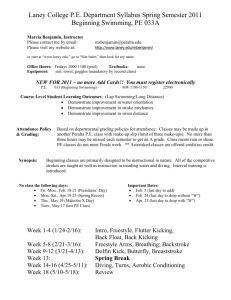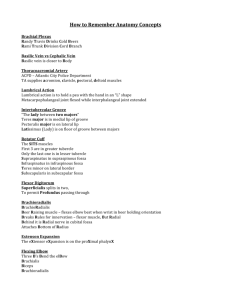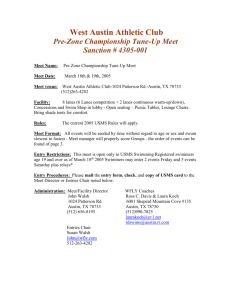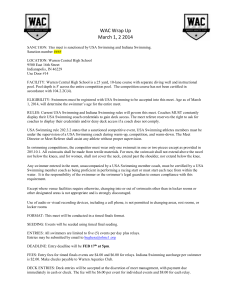Freestyle Swimming Muscle Analysis 1 A Comprehensive Joint and
advertisement
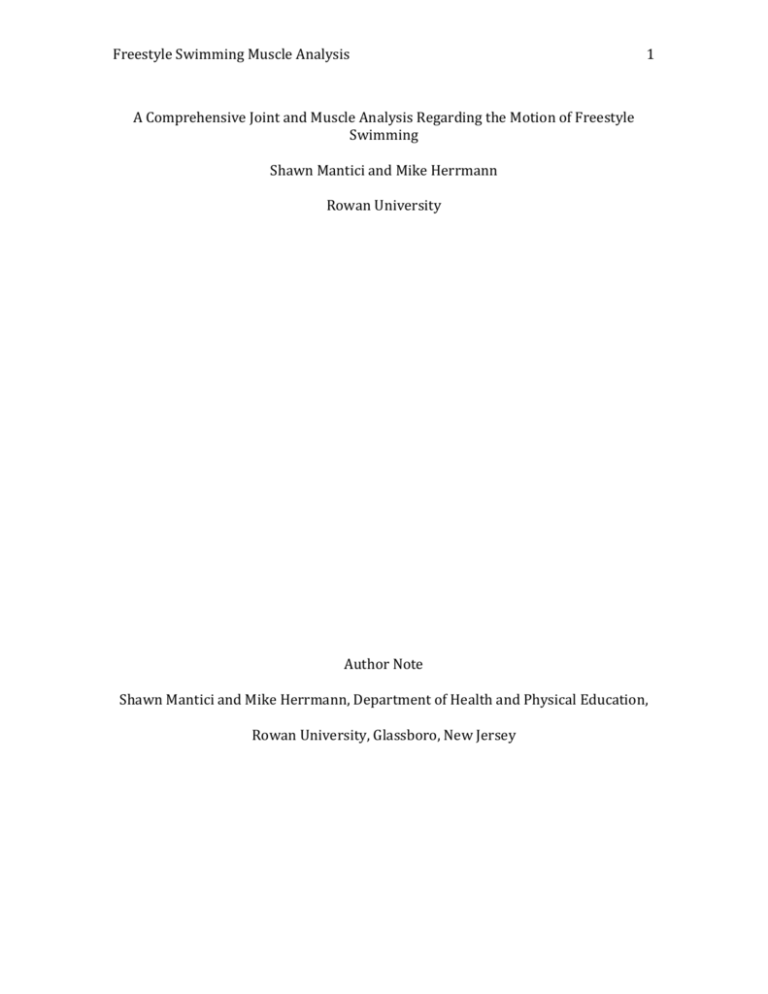
Freestyle Swimming Muscle Analysis 1 A Comprehensive Joint and Muscle Analysis Regarding the Motion of Freestyle Swimming Shawn Mantici and Mike Herrmann Rowan University Author Note Shawn Mantici and Mike Herrmann, Department of Health and Physical Education, Rowan University, Glassboro, New Jersey Freestyle Swimming Muscle Analysis 2 Abstract The freestyle swimming stroke incorporates nearly all muscles and joints of the body, including core, shoulders, neck, arms, upper back, chest, and legs to maintain a constant freestyle motion to be as efficient as possible. The muscles used in the freestyle stroke are broken down by the joints in which their movement occurs. Gravitational force plays a significant factor in the motion and balance that can be altered by proper body placement. Freestyle Swimming Muscle Analysis 3 The freestyle swimming stroke incorporates numerous muscles including primary and supporting movers. The stroke technique begins with the swimmer pushing their feet off of the wall with both arms extended overhead with your palms pronated and knees extended. This is followed by simultaneously kicking both feet together as if they are attached. The head should be lined up with the trunk, as the swimmer looks downward. As the stroke cycle begins, the top of the swimmers head should meet with the surface of the water. The body roll begins with one arm coming out of the water in scapula upward rotation with the elbow flexed as about ninety degrees, coming back into contact with the water directly in line with the head with a slicing hand motion. The elbow should be fully extended by the time it is fully submerged back into the water, directly in a straight line with the torso. The arm now in from of the head uses wrist flexion and scapula downward rotation to propel the body forward. The opposite arm now repeats this motion. The hip should be extended at all times throughout the freestyle swim stroke cycle. The hip also internally and externally rotates depending on which motion the arm is doing related right or left side. When the right arm is extended into the water in front of the head, the right side hip is internally rotated, while the left side of the hip is externally rotated. The external rotation occurs while the hand on either given side is projecting the body forward through the water. During the freestyle stroke, the legs continuously take turns kicking, with the knees slightly flexing and extending to develop the kicking motion rhythmically with the arm and hip motions. While one knee is performing flexion, the opposite will Freestyle Swimming Muscle Analysis extend. The feet will continuously stay in planter flexion throughout the entire 4 cycle. Hand and Wrist Joints The wrist plays a vital role in any successful freestyle swimming stroke. It’s most significant action is wrist flexion, which provides the force to propel the body through the water in an efficient matter. This wrist flexion occurs when the elbow of the leading arm is fully extended forward in the water. The muscles used to carry out the wrist flexion motion include the flexor carpi radialis, Palmaris longus, flexor carpi ulnaris, flexor digitorum superficialis, flexor dittorum profundus, and flexor pollicis longus. These muscles play the role of agonist in the wrist flexion motion. During this motion, the metacarpophalangeal joints are adducted, as well as the thumb. This is used to create a more smooth motion through the water while decreasing resistance. The hand stays pronated throughout the entire cycle. Each arm alternates this motion in a rhythmic fashion to carry out the motion properly. The hand and wrist do not use any other motions throughout the cycle besides that of the wrist flexion of the leading arm. Elbow and Radioulnar Joints The elbow joint participates in flexion and extension throughout the freestyle motion. For the majority of the swim cycle, the elbow will stay flexed. The muscles used to carry out elbow flexion include the biceps brachii short head, brachialis, brachioradialis, and pronator teres. The extension motion of the elbow occurs in only one arm at a time. This is when the arm comes back into the water and fully extends in a line with the torso and is then followed by wrist flexion. The muscles Freestyle Swimming Muscle Analysis that perform this action are the triceps brachii long head, triceps brachii lateral head, triceps brachii medial head, and the aconeus. Elbow Flexion Synergist Biceps brachii, brachioradialis Neutralizers Pronator quadratus and pronator teres Antagonist Stabilizers Triceps, aconeus Lateral – Extensor carpi radialis brevis, extensor digitorum, extensor digiti minimi, extensor carpi ulnaris Medial – Pronator teres, flexor carpi radialis, palmaris longus, flexor carpi ulnaris, humeral head of flexor digitorum superficialis Elbow Extension Synergist Antagonist Neutralizers Aconeus Brachialis, Biceps Brachii, Brachioradialis Some rotator cuff activation may be necessary to neutralize the adduction and extension force. 5 Freestyle Swimming Muscle Analysis Stabilizers Lateral – Extensor carpi radialis brevis, 6 extensor digitorum, extensor digiti minimi, extensor carpi ulnaris Medial – Pronator teres, flexor carpi radialis, palmaris longus, flexor carpi ulnaris, humeral head of flexor digitorum superficialis Shoulder Joint After the wrist flexes on one are and pulls back down toward the body, it ends up in a position similar to the placement of the hand in the fundamental position. As the contralateral arm is extended and beginning wrist flexion, the arm along the body begins slight horizontal abduction and shoulder extension, which leads into full shoulder flexion and slight horizontal adduction as the arm comes back into contact with the water. The muscles used during horizontal abduction include the deltoid middle fibers, deltoid posterior fibers, latissimus dorsi, infraspinatus, and teres minor. The muscles performing shoulder extension at the same time as horizontal abduction are the pectoralis major lower fibers, subscapularis, latissimus dorsi, teres major, infraspinatus, and teres minor. The muscles performing second phase of the shoulder movement starting with horizontal adduction include the pectoralis major upper fibers, pectoralis major lower fibers, coracobrachialis, and deltoid anterior fibers. The muscles that perform Freestyle Swimming Muscle Analysis shoulder flexion as the same time as horizontal adduction are the pectoralis major 7 upper fibers and deltoid anterior fibers. Shoulder Flexion Synergists Pectoralis major (clavicular head), Antagonist Latissimus dorsi, posterior deltoid, teres Neutralizers Stabilizers Shoulder Extension coracobrachialis, biceps brachii major, long head of tricep Posterior deltoid, infraspinatus, teres minor and middle deltoid Rotator cuff – supraspinatus, infraspinatus, teres minor, subscapularis Synergists Posterior deltoid, teres major, long head Antagonist Anterior deltoid, pectoralis major Neutralizers Stabilizers of triceps coracobrachialis, biceps brachii Posterior deltoid, infraspinatus, teres minor, middle deltoid . Rotator cuff – supraspinatus, infraspinatus, teres minor, subscapularis Freestyle Swimming Muscle Analysis Shoulder Horizontal Abduction 8 Synergists N/A Neutralizers Anterior deltoid subscapularis . middle Antagonists Stabilizers Pectoralis major, anterior deltoid deltoid, latissimus dorsi, teres major, and coracobrachialis Rotator cuff – supraspinatus, infraspinatus, teres minor, subscapularis Shoulder Horizontal Adduction Synergists Anterior deltoid Neutralizers Posterior deltoid, infraspinatus, teres Antagonist Stabilizers Posterior deltoid minor, Middle deltoid, latissimus dorsi, teres major, and coracobrachialis Rotator cuff – supraspinatus, infraspinatus, teres minor, subscapularis Head and Neck During the freestyle swim stroke, the neck muscles are used only when the head performs cervical rotation in order for the swimmer to breath. When the Freestyle Swimming Muscle Analysis swimmer rotates his or her head varies, depending on the swimmers preference. However, when the swimmer uses cervical rotation, it is contralateral to the side of 9 the arm that is extended forward in front of the head. The muscle used in this action is the sternocleidomastoid. Back In regards to the back, the scapula is the key in performing the freestyle swimming stroke. When the arm that is close to the body similar to its position in the fundamental position, it first adducts and retracts the scapula, and then begins upward rotation in order to correctly perform the stroke. The muscles used in the adduction phase are the trapezius middle fibers, trapezius lower fibers, and rhomboids. The muscles that are responsible for scapula upward rotation are the serratus anterior, trapezius upper fibers and trapezius middle fibers. Scapular Upward Rotation Synergist Antagonist Neutralizers Stabilizers Upper and lower trapezius Pectoralis minor, rhomboids, levator scapulae Lower trapezius muscle acts to prevent elevation caused by upper trapezius. Serratus anterior, rhomboids, levator scapulae Freestyle Swimming Muscle Analysis Scapular Adduction Synergist Antagonist Neutralizers Stabilizers Scapular Retraction 10 Pectoralis major (sternal head), coracobrachialis, long head of triceps, infraspinatus, teres minor, subscapularis Anterior deltoid, middle deltoid, biceps brachii Posterior deltoid, infraspinatus, teres major Rotator cuff – supraspinatus, infraspinatus, teres minor, subscapularis Synergist Rhomboids Neutralizers Upper and lower trapezius muscle Antagonist Stabilizers Serratus anterior, pectoralis minor Serratus anterior, rhomboids, levator scapulae Core and Abdominals Arguably, the most vital muscles that are used during freestyle swimming are the core muscles. The core not only helps link the upper and lower muscles of the body, but also allow for the body-rolling movements to take place during the stroke. The abdominal muscles including the external and internal obliques and transverse Freestyle Swimming Muscle Analysis 11 abdominis are critical in the freestyle swim stroke because of their actions of trunk flexion, lateral trunk flexion, and trunk rotation. The most crucial, however, is the stabilization of the abdominals and lower back during the entire swim. The lateral muscles group acts to hold the core in a stabilized position and is the primary muscle contributing to the stabilization process. Trunk Flexion Synergist External Obliques, Internal Obliques, Antagonist Erector Spinae -Iliocostalis, Longissimus, Neutralizers Stabilizers Psoas Spinalis, Latissimus Dorsi External Obliques internal obliques Intrinsic stabilization-Transverse abdominis, intrinsic muscles of spine, diaphragm, pelvic floor Trunk Lateral Flexion Synergist Antagonist Ipsilateral external oblique and internal oblique, ipsilateral erector spinae, ipsilateral latissimus dorsi Contralateral quadratus lumborum, contralateral external and internal Freestyle Swimming Muscle Analysis Neutralizers obliques, contralateral erector spinae, 12 contralateral latissimus dorsi Erector spinae neutralizes flexion force created by obliques, intrinsic stabilization system creates posterior shear force on lumbar spine to neutralize lumbar extension, rectus abdominis and psoas prevent ancillary Stabilizers extension. Rectus abdominis, psoas, intrinsic stabilization subsystem -Transverse abdominis, intrinsic muscles of spine, diaphragm, pelvic floor Trunk Rotation Synergist Ipsilateral latissimus dorsi, Antagonist Opposing external and internal oblique Neutralizers contralateral psoas Erector spinae obliques, quadratus lumborum obliques, rectus abdominis ,latissimus dorsi Stablizers Intrinsic stabilization subsystem- Freestyle Swimming Muscle Analysis Transverse abdominis, intrinsic 13 muscles of spine, diaphragm, pelvic floor Hip and Pelvic Girdle The pelvis’s only action in the freestyle swim stroke is external and internal rotation. Internal rotation occurs on the same side as the arm that is extended straight into the water past the head. The pelvis is performing external rotation contralaterally during this movement. The muscles involved with internal rotation are the gracilis, semitehdinosus, and semimembranosus. The external rotators include the illiacus, psoas major and minor, pectineus, biceps remoris, gluteus maximus, piriformis, gemellus superios, gemellus inferior, obturator internus, obturato externus, and quadratus femoris. Hip Internal Rotation Synergist Antagonist Anterior fiber of gluteus medius, tensor fascia latae, semitendinosus, semimembranosus, anterior adductors Gluteus maximus, posterior fibers of gluteus medius, biceps femoris (long head), posterior head of adductor magnus, deep rotators of hip, sartorius Freestyle Swimming Muscle Analysis Neutralizers Gluteus maximus, gluteus medius Stablizers Deep rotators of hip Hip External Rotation Synergist 14 gluteus minimus Deep rotators of hip, gluteus maximus, posterior fibers of gluteus medius, biceps femoris (long head), posterior Antagonist head of adductor magnus, sartorius Anterior fiber of gluteus medius, gluteus minimus, tensor fascia latae, semitendinosus, semimembranosus, Neutralizers Stablizers anterior adductors Hip flexors, anterior adductors Deep rotators of hip, gluteus medius, gluteus minimus Knee Joint The knee joints primary function in the freestyle swim stroke is flexion and extension. These two movements are crucial to performing the dolphin kick during the swim stroke, which involves both legs and feet continuously kicking upward and downward contralaterally. While one knee is flexing, the other is extending. The Freestyle Swimming Muscle Analysis muscles used in knee flexion include the biceps femoris, popliteus, 15 semimembranosus, and semitendinosus. The muscles used in knee extension are the rectus femoris, vastus intermedialis, vastus lateralis, and vastus medialis. Knee Flexion Synergist popliteus, gastrocnemius, gracilis, Antagonist vastus lateralis, vastus medialis, vastus Neutralizers sartorius intermedius, rectus femoris Balance between medial and lateral stabilizers of the knee must be maintained to prevent extreme internal or external rotation of the tibia. More complex relationships between synergistic pairs exist – for example, the short head of the biceps femoris and vastus medialis obliquus are functional Stabilizers antagonists. Medial stabilizers – Pes Anserinus group, medial gastrocnemius, and vastus medialis obliquus Freestyle Swimming Muscle Analysis Lateral Stabilizers – Gluteus maximus, 16 vastus lateralis , lateral gastrocnemius, plantaris,popliteus, Knee Extension Synergist vastus lateralis, vastus medialis, vastus Antagonist N/A Neutralizers intermedius, rectus femoris Careful balance between medial and lateral stabilizers of the knee must be maintained to prevent excessive internal or external rotation of the tibia. More complex relationships between synergistic pairs exist – for example, the short head of the biceps femoris and vastus medialis obliquus are functional antagonists. Stabilizers Medial stabilizers – Pes Anserinus group, semimembranosus, medial gastrocnemius, and vastus medialis obliquus, popliteusLateral Stabilizers – Freestyle Swimming Muscle Analysis Gluteus maximus, biceps femoris, and 17 lateral gastrocnemius, plantaris, Popliteus, Foot and Ankle Joint During the entire freestyle swim stroke, the ankle and foot perform plantar flexion. This is performed for the entire swim because it allows for better movement through the water because there is less resistance on the foot. The muscles used in planter flexion include the gastrocnemius, soleus, tibialis posterior, flexor digitorum longus, flexor hallucis longus, peroneus longus, and the peroneus brevis. Ankle Plantar Flexion Synergist Antagonist Neutralizers Fibularis longus, fibularis brevis, posterior tibialis, flexor hallucis longus, flexor digitorum longus, plantaris Tibialis anterior, extensor digitorum longus, extensor hallucis longus, peroneus tertius posterior tibialis ,medial gastrocnemius ,lateral gastrocnemius and the fibularis Freestyle Swimming Muscle Analysis Stabilizers muscles. 18 Fibularis longus, fibularis brevis, fibularis tertius, posterior tibialis, anterior, flexor hallucis longus, flexor digitorum longus, extensor hallucis longus, extensor digitorum longus External Resistant Forces When executing the freestyle swim stroke, the hips and legs are the first to sink down into the water due to gravity, which is referred, to as the hip drop. This makes it more difficult for the body to in the optimal position to execute the swim. “We are, however, in complete control of where that center of gravity is at any given time, within a certain range. The sooner we get a recovering arm out in front of the body the less hip drop we experience. The longer we keep the gliding arm in front of the body the less hip drop we have. And, on average, the longer we can keep both arms out in front of the body the less hip drop we will see.” (Hines, 1994, P. 1). The idea, overall is to get the leading arm out in front as quickly and effectively to increase the body’s buoyancy and to balance the body’s center mass. The lungs also play a key role in the process buoyancy. The more air in the swimmers lungs, the more it lifts the upper torso toward the surface. Although your lungs, body fat percentage, and bone density all play roles in the gravitational forces, the greatest controllable factor is the body’s position in relation to the placement of the swimmers body parts. Freestyle Swimming Muscle Analysis Conclusion 19 As described, the joints and muscles throughout the body are elaborately used to conduct proper freestyle swimming technique, proving that the freestyle swim stroke is one of the more complex sports motions that the body can perform. Numerous muscles starting from the finger and ending in the feet are in constant motion, creating and resisting forces in the process. This process proves to be complex in that while one side of the body is performing an action motion, the other side must relax and stabilize parts of the body to allow this motion to happen. This occurs in multiple parts of the body at the same time in a rhythmic fashion, making the process even more complex. This explains how the joints and muscles of the body, work together to perform small specific motions to carry out an overall full body motion in that of the freestyle swim stroke. Freestyle Swimming Muscle Analysis 20 References Brookbush, B. (2011). Category archives kinesiology. Retrieved December 8, 2012, from http://b2cfitness.com/cpt_blog/category/kinesiology/ Floyd, R. T. (2012). In Huenefeld L., Paulsen H. and Roybal M. (Eds.), Manual of structural kinesiology (18th ed.). New York, NY: The McGraw-Hill Companies,INC. Hines, E. (2012). Of gravity and air. Retrieved December 8, 2012, from http://www.usms.org/articles/articledisplay.php?aid=78 McLeod, I. (2012). A strong core is essential for powerful swimming. Retrieved December 8, 2012, from http://www.humankinetics.com/excerpts/excerpts/a-strong-core-isessential-for-powerful-swimming
